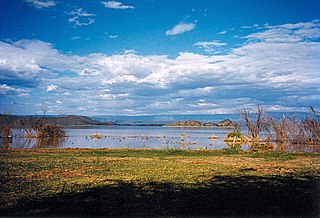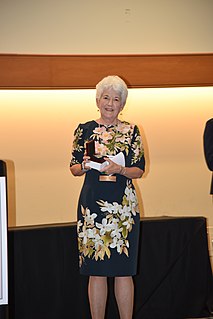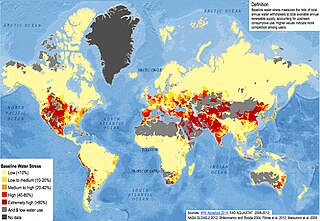
Lake Baringo is, after Lake Turkana, the most northern of the Kenyan Rift Valley lakes, with a surface area of 130 square kilometres (50 sq mi) and an elevation of 970 metres (3,180 ft). The lake is fed by several rivers, Molo, Perkerra and Ol Arabel, and has no obvious outlet; the waters are assumed to seep through lake sediments into the faulted volcanic bedrock. It is one of the two freshwater lakes in the Rift Valley in Kenya, the other being Lake Naivasha. In a remote location in a hot and dusty area with over 470 species of birds, occasionally including migrating flamingos. A Goliath heronry is located on a rocky islet in the lake known as Gibraltar.

Meave G. Leakey is a British paleoanthropologist. She works at Stony Brook University and is co-ordinator of Plio-Pleistocene research at the Turkana Basin Institute. She studies early hominid evolution and has done extensive field research in the Turkana Basin. She has Doctor of Philosophy and Doctor of Science degrees.

The Suguta Valley, also known as the Suguta Mud Flats, is an arid part of the Great Rift Valley in Kenya (Africa), directly south of Lake Turkana.

Sibiloi National Park lies on the northeastern shore of Lake Turkana in northern Kenya. Established in 1973 by the government of Kenya for the protection of wildlife and palaeontological sites there, it covers 1570 km² and is internationally known for its fossils. It was listed as a UNESCO World Heritage Site in 1997 as a part of Lake Turkana National Parks.

Koobi Fora refers primarily to a region around Koobi Fora Ridge, located on the eastern shore of Lake Turkana in the territory of the nomadic Gabbra people. According to the National Museums of Kenya, the name comes from the Gabbra language:
In the language of the Gabbra people who live near the site, the term Koobi Fora means a place of the commiphora and the source of myrrh...

KNM ER 1813 is a skull of the species Homo habilis. It was discovered in Koobi Fora, Kenya by Kamoya Kimeu in 1973, and is estimated to be 1.9 million years old.

KNM ER 1805 is the catalog number given to several pieces of a fossilized skull of the species Homo habilis. It was discovered in Koobi Fora, Kenya in 1974. The designation indicates specimen 1805, collected from the east shore of Lake Rudolf for the Kenya National Museums.

KNM ER 3733 is a fossilized hominid cranium of the extinct hominid Homo ergaster, which is interchangeably referred to as Homo erectus. It was discovered in 1975 in Koobi Fora, Kenya, right next to Lake Turkana, by Bernard Ngeneo, a field worker for Richard Leakey. Its geographic location is not to be confused with that of KNM WT 15000, Turkana Boy, also known as Nariokotome Boy, who was also found near Lake Turkana nine years later in 1984.

The Bouri Formation is a sequence of sedimentary deposits that is the source of australopithecine and Homo fossils, artifacts, and bones of large mammals with cut marks from butchery with tools by early hominins. It is located in the Middle Awash Valley, in Ethiopia, East Africa, and is a part of the Afar Depression that has provided rich human fossil sites such as Gona and Hadar.

Lokitaung is a settlement in Kenya's Turkana County, a few miles inland of northwest Lake Turkana. Lokitaung is the site of the 36-million year old Lokitaung Basalt lava flows, which lay atop Cretaceous sediments including dinosaur bones. The basalts are over 1 kilometer thick, and approximately 100 kilometers wide.
Loxodonta exoptata is an extinct species of elephant in the genus Loxodonta, from Africa. A 2009 study suggested that Loxodonta exoptata gave rise to L. atlantica, which gave rise to L. africana. The molars of L. exoptata are distinguished from later loxodonts by the lower plate number and their specialized enamel loops. Fossil remains of L. exoptata have been found at Pliocene sites in eastern Africa including Laetoli and Koobi Fora.

The greater Turkana Basin in East Africa determines a large endorheic basin, a drainage basin with no outflow centered around the north-southwards directed Gregory Rift system in Kenya and southern Ethiopia. The deepest point of the basin is the endorheic Lake Turkana, a brackish Soda lake with a very high ecological productivity in the Gregory Rift.

Anna Katherine "Kay" Behrensmeyer is an American taphonomist and paleoecologist. She is a pioneer in the study of the fossil records of terrestrial ecosystems and engages in geological and paleontological field research into the ecological context of human evolution in East Africa. She is Curator of Vertebrate Paleontology in the Department of Paleobiology at the Smithsonian Institution's National Museum of Natural History (NMNH). At the museum, she is co-director of the Evolution of Terrestrial Ecosystems program and an associate of the Human Origins Program.

Loriu Plateau is an elevated Precambrian bedrock exposure at the southwest margin of Lake Turkana in Kenya. The plateau is only seasonally habitable due to aridity and was once home to fauna otherwise rare in Turkana. Loriu is west of and adjacent to the Barrier Volcano at the southernmost portion of Lake Turkana.

Kanapoi is a paleontological site in the Kenyan Rift Valley, to the southwest of Lake Turkana. Fossils were first found at Kanapoi in the 1960s by a Harvard expedition, and later by expeditions from the National Museums of Kenya.

Aiyangiyang is a basin in southern Turkana, Kenya, southeast of Lodwar. It is known by nomadic pastoralists for its seasonal water availability, and is an important archaeological and paleontological site with artifacts and remains from the African Middle and Late Stone Ages.

Francis Harold Brown was an American geologist and geochemist who mapped the sedimentary sequence and geology of most of the Turkana Basin in Kenya, east Africa. Brown introduced single-crystal argon-argon and potassium-argon dating into the Turkana Basin, resolving disputes over the age of Kenyanthropus platyops and other fossils.
The KBS Tuff is an ash layer in East African Rift Valley sediments, derived from a volcanic eruption that occurred approximately 1.87 million years ago (Ma). The tuff is widely distributed geographically, and marks a significant transition between water flow and associated environmental conditions around Lake Turkana shortly after 2 Ma.





















